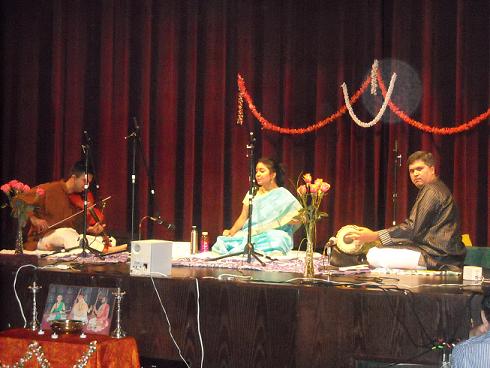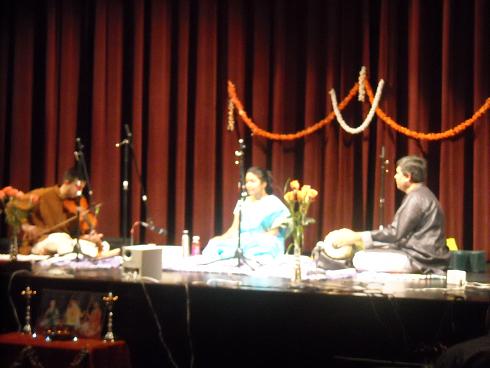Contribute
| Melodious Modulations - Amrita Mangalat |
Haribabu Arthanari
09/25/2009
It was culmination of 12 years of rigorous training in one of the complex music system, the karnatak music. Amritha Mangalat presented a delightful performance in her maiden attempt at a full concert (Arangetram). She was accompanied by Sri Surya Sundararajan on the violin and Sri Gaurishankar Chandrashekar on the mrudangam. Amritha has been under the tutelage of Smt. Sandhya Sridhar for the last decade learning vocal music. Sandhya herself was a student of Smt. Alamelu Mani, a renowned musician trained by the legendary Sri. Musri Subramanya Iyer and Smt T.Brinda. Given the stature of her guru and her lineage, Amrita had a tall order in front of her with high expectations. In addition to karnatak vocal. Amritha had been learning veena with Smt. Durga Krishnan, barathanaytam with Smt. Poornima Gururaja and Smt. Sunanda Narayanan and Mohiniyattam under Kumari Neha Parikh.
The concert commenced with the classic Ata tala varnam "Nera Nammithi" in the ragam Kanada, a composition of Poochi Srinivasa Iyengar. The varnam was faithfully rendered in two speeds. This was followed by Dikshitar's evergreen "Vatapi Ganapatim" in the ragam Hamsadhwani set to Adi talam. This belongs to a set of sixteen songs composed by Dikshitar, in praise of all sixteen forms of Ganesha (Shodasa Ganapati Kritis) found in Tiruvarur. The composition was embellished with crisp kalpana swarams by both Amritha and Surya. Amritha then embarked on a contemplative Sivapantuvarali (Subhapantuvarali) with a rare Dikshitar kriti "Pashupatheeswaram" in Adi talam and aptly created the melancholic allure inherent to the ragam.
The main piece was Thyagaraja's classic "Pakala Neelabadi" in the ragam Karaharapriya, one of the oldest ragams whose origin can be traced to Tamil pan music, circa 500 BC (Kodi Palai). Though the ragam is old, the current manifestation of the ragam owes its due to Thyagaraja who has composed a number of masterpieces in Karaharapriya. With the absence of Karaharapriya in the Dikshitar’s asampoorna mela system, Thyagaraja practically owned the ragam. Pakala neelabadi, in mishra chapu talam, was preceded by a brief sketch of ragam by Amritha and Surya. Amritha’s rendition of the song reflected the authentic padantharam of the school and the bhavam brought out the emotive aspect of the composition, where Thyagaraja wonders what is it like to stand next to Rama. There was an elegant exchange of neraval at "Tanuvuche Vandana" and swaras between Amritha and Surya followed by a refined and pleasing taniavartanam by Gaurishankar.
The next piece was Panchanadha Iyer‘s “Arabimanam†a composition that traverses a dozen ragams in quick succession with some scintillating chitta-swaram passages. The composer has subtly etched the name of the ragam in the sahityam and Amritha's rendition was flawless, distinctly establishing the individual ragams in the short duration.
The RTP was in the ragam Simhendremadyamam , a tribute to the legend Smt. D.K. Pattamal. Amritha explored the melodic and aesthetic aspects of the ragam, establishing complete control over two octaves. Surya showcased the intricate landscape of the ragam revealing the subtle nuances that can be explored on the violin. The Pallavi "Thaaye ninadhu padhame, Thara venum Annapoorneshwari" was in Chaturashra Jathi Rupaka talam.
The highlight of the concluding section of the concert was Dikshitar’s masterpiece “Mamava patabirama†in the ragam Manirangu. One probably should need a license to sing this song as the composition is loaded with rich gamakas and emotive phrases. Amritha displayed an unswerving allegiance to classical ideals in rendering this song.
The concert concluded with Sreenivasa (Hamsanandi), Sarasamukhi (Gauda Malahar), Aliveni (Kurinji), Paratpara (Vachaspati) , Tillana (Desh) and Mangalam. The padam Aliveni, a composition of Swati Tirunal, was rendered in a slow, bhava-laden fashion, as the composition rightly deserves.
The concert was very well planned, presenting an array of diverse ragams, talams and composers. One of the challenges of learning karnatak music in the western hemisphere is in understanding the context of the music, in addition to the tonal and rhythmic components. The context is critical to elicit the appropriate bhavam, which each composition demands. Amritha’s schooling with Sandhya, her training in other instruments and dance aided to deliver a radiant performance, which was brilliantly supported by Surya and Gaurishankar. As Amritha mentioned, the efforts and sacrifices of her parents were vital in her musical development. We, in the greater Boston area, hope that this was one elegantly big step for Amirtha and expect many more great leaps in the years to come.
You may also access this article through our web-site http://www.lokvani.com/

